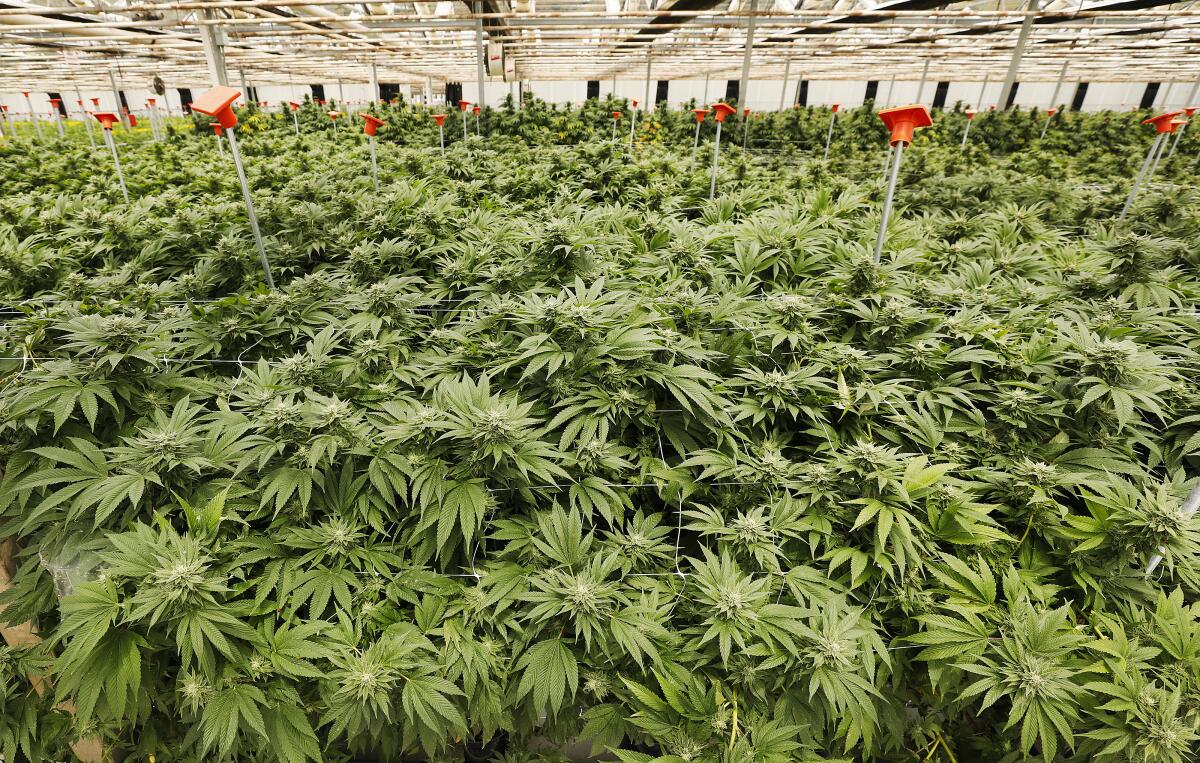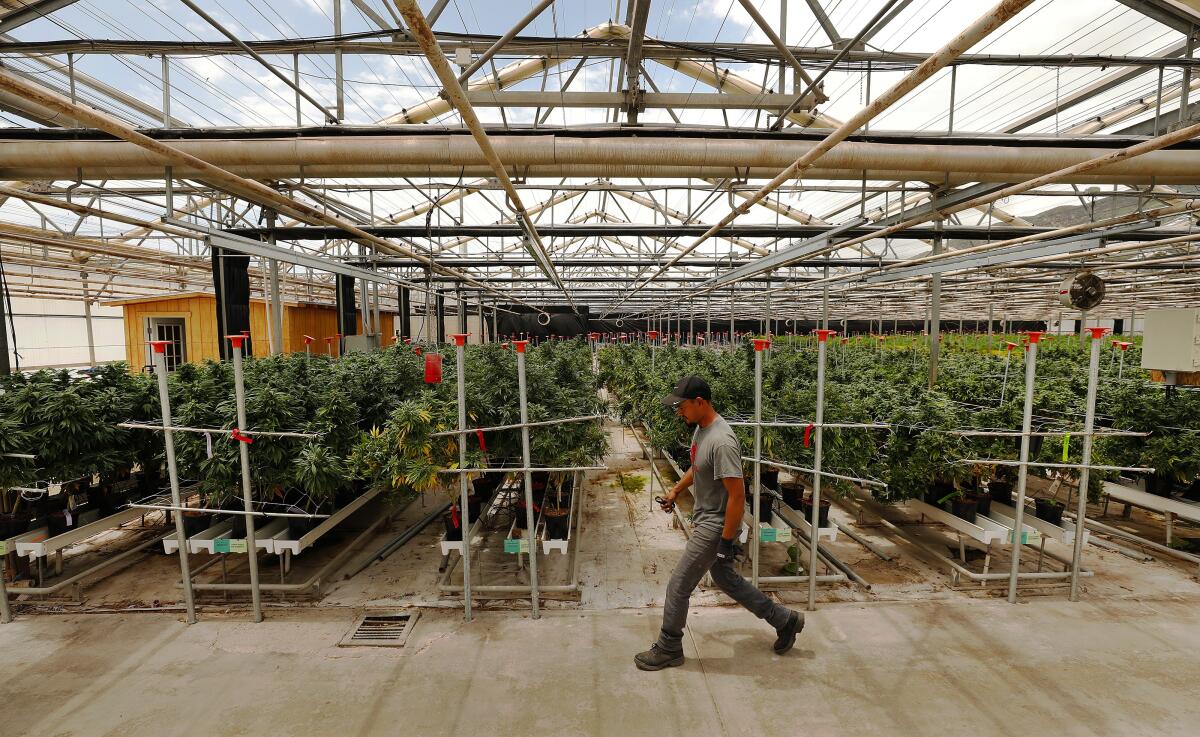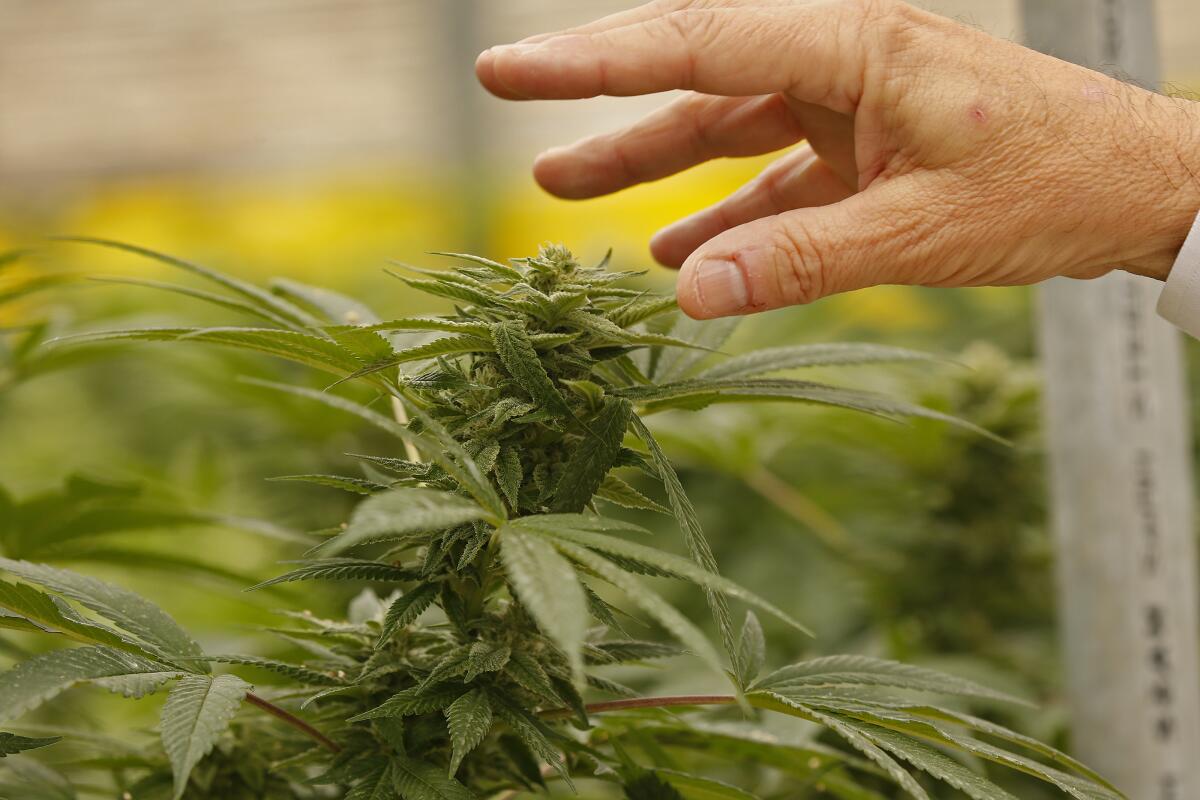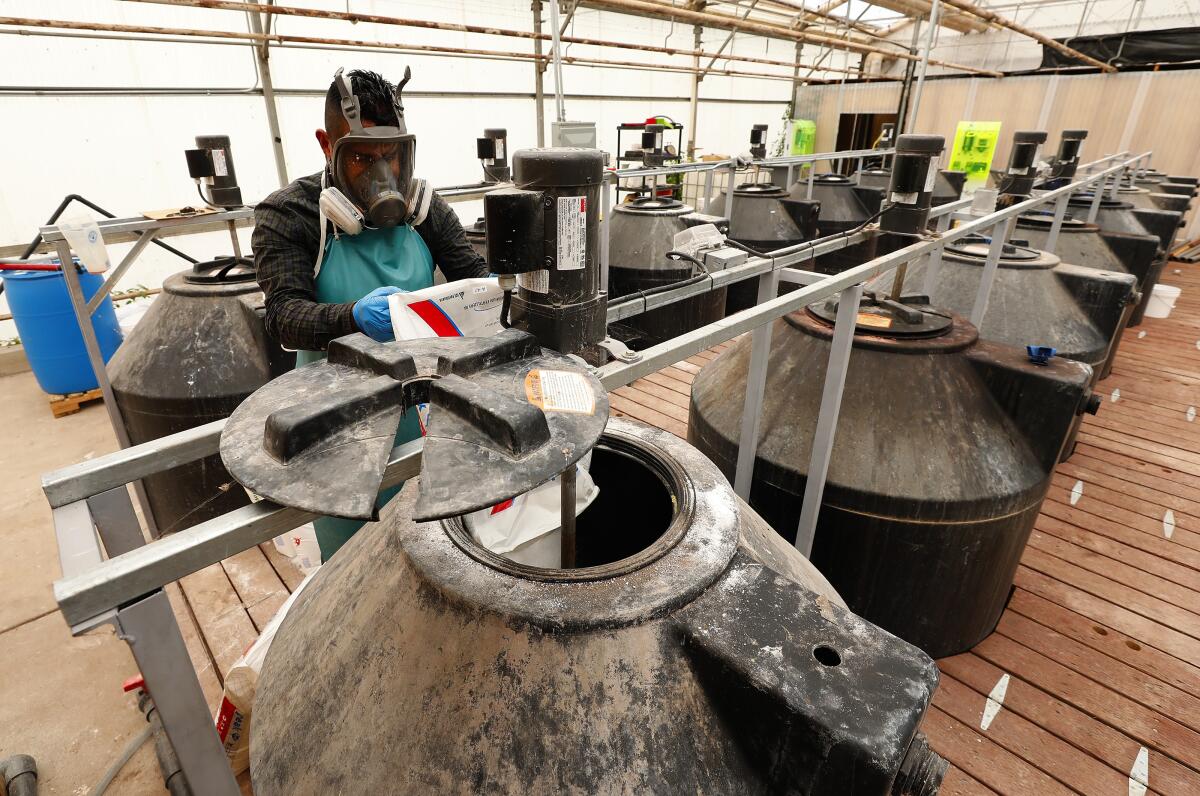Cannabis farm was a model for California’s legal industry. Then came a sheriff’s raid

- Share via
To marijuana industry boosters and Santa Barbara County officials, Barry Brand was one of the “good players,” a longtime Gerbera daisy grower who pitched cannabis as just a new type of flower in the greenhouse.
When county officials gave reporters a tour of a licensed grow last year, they picked Brand’s operation on Foothill Road to showcase how their regulations were working and would make it all but impossible to divert marijuana to the black market.

Last month the Santa Barbara County sheriff revealed a crease in this tidy snapshot. On Jan. 22, detectives served a search warrant at the farm and reported finding a stash of more than 100 gallons of concentrated cannabis oil, an extraction lab and evidence of “off-book” sales” — all illegal.
“They were considered to be sort of the models,” said Bernard Melekian, the former undersheriff who became the county’s cannabis czar last month. He chuckled about his predecessor taking The Times on a tour of the farm in May. “I realize there is a certain irony there.”
He added that the tracking system is “nowhere near up and running” and had nothing to do with the sheriff’s search.

Lionel Neff, a critic of the proliferation of cannabis in the area, said “no one was surprised” by the raid at Brand’s Arroyo Verde farm, one of many operations accused of fouling the air in Carpinteria.
“If they were good operators, they would have taken the community into account from the beginning.”
Neff is hopeful that the raid is a sign that Melekian is going to take a harder look at the politically connected farmers than county officials have in the past.
Brand, 57, is a prominent member of one of the two Dutch families — the Brands and Van Wingerdens — who brought the cut-flower industry to the Carpinteria Valley decades ago. The clans are intertwined and now growing marijuana in their numerous sprawling greenhouses north of town.
Barry Brand has been an influential figure in this town of just 13,000. He is active in the Lions and Rotary clubs, and was one the 15 members of the industry group CARP Growers (Cannabis Assn. for Responsible Producers). In August, the group agreed to donate $189,000 to the Carpinteria Unified School District. In September, he and his wife co-hosted a fundraiser for the local Girls Inc. and donated $10,000 for their table. The gala brought in over $250,000.

The Jan. 22 raid highlights how little officials knew about the operations they approved for state licensing.
In the last two years, county supervisors voted to allow grows of unlimited size and number, with little or no vetting, turning a county famous for its wine-tasting and scenic coastline into California’s new and unexpected breadbasket of marijuana cultivation.
Brand and other growers were heavily involved in developing the cannabis policy, hiring lobbyists, attorneys and communications firms, making donations to political campaigns. Brand contributed $10,000 to the two county supervisors leading the effort: $8,000 to Das Williams and $2,000 to Steve Lavagnino.
The unregulated rush of planting sparked clashes from the south coast to Santa Maria. In this seaside town, neighbors and school children complained about the plant’s skunk-like odor, while other residents and some businesses counter that the jobs and tax revenue are good for the local economy.
By summer of last year, growers in Santa Barbara County had obtained more state licenses than places like Humboldt and Mendocino. Humboldt now slightly edges out Santa Barbara, which after a backlash put a cap on the total number of acres that could be cultivated with pot countywide.
On Jan. 20, attorneys for a coalition of critics of the industry sent a letter to the U.S. attorney in Los Angeles asking to launch “an investigation of commercial cannabis cultivators that are operating within 1,000 feet of schools.” The petition sought enforcement against the county, under the Civil Rights Act, citing “pernicious impacts near schools attended by predominantly Hispanic children.”
When The Times toured the facility, Dennis Bozanich, the county executive who worked with supervisors to create the cannabis policy, said a tracking system and regular inspections would make it difficult for growers to divert even 2% of their crop to the black market.
Brand’s manager, who asked not to be named at the time, was more skeptical.
“Depending on how the operator wants to game the system, I’m sure there are ways to do it,” he said. “All of this depends on a partnership between the good operators and the county and the state.”

The stated goal of Santa Barbara’s cultivation program was to bring tens of millions in tax revenue. But the Board of Supervisors, guided by Bozanich, Williams and Lavagnio, created a system with loopholes.
For one, they voted for a 4% tax on gross receipts instead of a tax based on licensed square footage of the crop. Because the county has no access to the state tracking data, and growers operate in a cash world with little or no banking records, the tax collector’s office has had to rely on their word about how much they made.
Consultants said in February 2018 that the county could expect to collect between $15 million and $22 million annually from the 47 acres licensed to grow at that point.
Nearly six times that number of acres, 275, are licensed now, records show.
But in the last year and a half, the county received only $9.76 million.
As an indicator to how much of the cannabis is flooding the underground market: Sheriff searches of 29 unlicensed operators and 15 licensed ones turned up $294 million worth of illegal product, Melekian said. And with multiple crop cycles, those operators could have had several times that amount over the course of a year. At the same time, licensed growers reported only $167 million in legal revenue in the last fiscal year to the county.
Sheriff’s spokeswoman Raquel Zick said the investigation into Brand was continuing. The sheriff searched Brand’s four parcels on suspicion that he was “growing and processing marijuana outside of the licensed parcel as well as possessing and selling cannabis crude (oil) without a license.”
Detectives discovered “off-book [black market] marijuana sales associated with the farm,” a small volatile extrication lab, about 20 pounds of illegally stored cannabis and “1,000 pounds of cannabis crude.” That amount of crude oil sold wholesale would be worth between $1.1 million to $1.6 million in California’s legal market, much more out of state, according to industry insiders.
CARP Growers, which was heavily involved in crafting the county’s marijuana policy, said Brand resigned his membership after the raid. Brand did not return calls and emails seeking comment.
Just four days before the sheriff’s search, Brand opened his farm to 100 “community members” for a tour that presumably did not include the extraction lab, which are known to explode, if not done to professional standards.
“We love to share how our plants have helped bring relief to those in need,” Brand told Coastal View magazine. “I had a great day sharing our wonderful farm with the public.”
More to Read
Sign up for Essential California
The most important California stories and recommendations in your inbox every morning.
You may occasionally receive promotional content from the Los Angeles Times.














